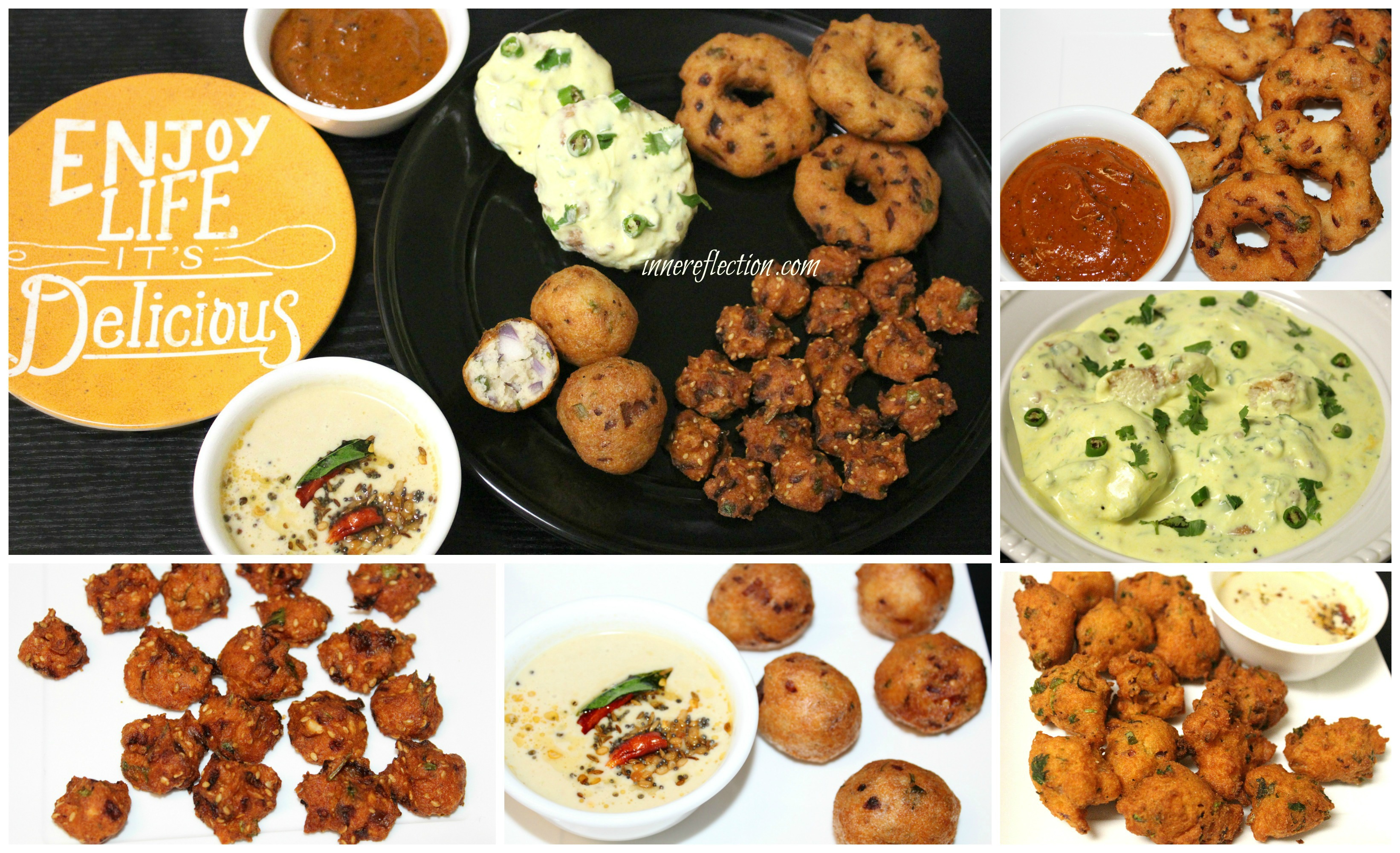
Vada- A must have on the platter on a festive day or any special occasion in every South-Indian household. This Indian donut is my favorite savory dish and is always on the top of my cook list for any special or festive meal at home. The traditional food platter which is eaten on a banana leaf seems incomplete without this vada at one of it’s corners! Often eaten along with sambar or chutneys, this vada won the hearts of many around the world. Mostly found with Idli in menus as ‘Idli-Vada’, this is a special breakfast dish for most of the people.
Medu vada which is called garelu in telugu, is traditionally made of urad dal. Although many instant recipes have come up these days using bread, poha or dahi (yogurt), this traditional medu vada always leads the way when it comes to taste. Some people might feel that the grinding process is a bit tough, as the lentils are ground without using much water or almost no water, which takes a bit more time and effort, but it’s worth it when you taste them!
My mom makes these vadas on every single occasion and festive day at home; it could be anyone’s birthday, puja or guests coming home and the first thing she’d say is “I will prepare garelu (vada)” and whenever she prepares it she also prepares some ginger chutney to eat with these vadas. It’s one of the many hit combinations from her recipes. She has a huge wet grinder at home in which she grinds the lentils unlike these blenders or food processors which most of us who live outside India use, and that’s the secret behind the fluffy and crunchy vada that she makes till date. She is 73 now, but she won’t compromise on using this special grinder. As we’re a family of 7 (my parents and 5 siblings) she always used to make these vadas in huge quantities, and yet she’d be left with 1 or 2 vadas to eat for herself. We liked them so much that we couldn’t stop eating till we were done. Mothers always feed their children first and don’t think for themselves, do they? Kindness and selflessness is what a mother is made of. The same thing happens with me when I cook something special at home; it never lasts more than a few minutes! But never mind that, my stomach fills up seeing my kids enjoying my food 🙂

I’m sharing my version of making medu vada which I learnt from my mom that turns out incredibly well every time I prepare it. The batter which I use to make medu vada can also be used for various dishes. I’m sharing the detailed recipe of each dish that I made using the same batter. Hope you’ll like the recipes and give them a try. And please do share the pictures of your food with me so that I can share them on this blog and other social media! 🙂
Medu Vada/ Garelu recipe:
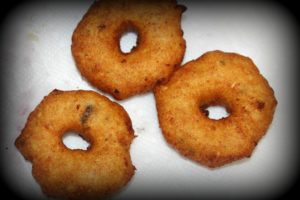
Wash the urad dal 2-3 times till its clean enough. Soak the dal in a big vessel or container with a lot of water for a minimum of 4-6 hours or overnight. For vada it’s always recommended to use the whole urad dal and not the split ones as the whole white urad makes the vada soft and fluffy.
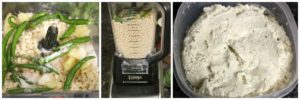
Add the urad dal to a blender jar or grinder. Add a few washed and cleaned green chilies, a small piece of ginger and salt to taste. Do not add any water to grind. Grind it into a coarse paste, pausing in between to scrape off the sides of the jar to mix it well. Be a little patient while grinding the batter. Add just a few drops of water if necessary. Giving it a mix every few seconds help the lentils grind faster and better. The Vada batter shouldn’t be too fluffy like the Idli batter otherwise it will absorb a lot of oil and won’t taste good. Try a little batter to check the salt and spices and add if required. Green chilis and ginger can be used in offerings to God, so you can add them in the batter for naivedyam (offerings). But if you still don’t want to add the spices, you can skip them and just grind plain lentils with salt. Always grind the batter just before you want to fry the vadas, as keeping the batter for longer hours will again make the vada very oily, thereby spoiling its taste.
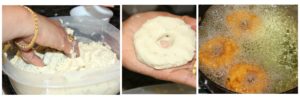
Transfer the batter to a bowl or container. Heat oil in a pan to deep fry the vadas. Use a heavy bottom kadai or pan for deep frying. When the oil is hot enough, start making the vada. Keep a bowl of water ready to dip your fingers in while making the vada. Take a small portion of batter in hand, shape it into a ball and then gently press it with your thumb to flatten it and make a hole in the centre so that it cooks evenly all over. Gently drop it in the oil. You can also shape the vada on a greased sheet if you are comfortable that way. Be very careful while dropping the vada in the oil and don’t drop it very fast as there is a risk of getting oil spilt on you. Deep fry 3-4 vadas per batch depending on the size of the vessel. Keep the heat in medium while frying and fry the vadas till they turn golden in color. Flip them and cook on the other side. Remove them from the oil and drain on a paper towel. Serve them hot with a nice chutney, like coconut or ginger chutney and sambar.
Masala Vada Recipe:
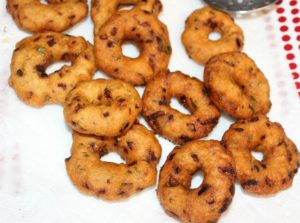
To make Masala vada, add some finely chopped onions, chilis and coriander leaves. As the chilies were already added before in my batter, I didn’t have to add them again. Once we add the onions, the batter thins up a bit, so it’s preferred not to leave the batter for long after adding the onions or else it’ll lose the ability to form the shape of a round vada. Follow the same procedure as above to make the vadas and deep fry them in the oil ’til they turn nice golden brown and are cooked well. Remove them, place on a paper towel and drain. Serve them hot with any chutney or sambar and enjoy!
Click here to check the recipes of a wide range of chutneys on my blog!
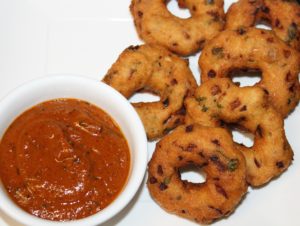
Dahi Vada (Perugu vada/ Avada) Recipe:
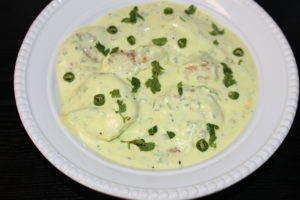
This Dahi Vada is called Perugu vada or Avada in telugu. It is a South-Indian version of vada unlike the other dahi vada which we eat as a street food with green chutney and tamarind chutney on top. This version of dahi vada is not usually available in the restaurants. I often prepare a batch of this dahi vada every time I make the regular vada, as it doesn’t take much effort and time to prepare them. It’s normally prepared in the morning and eaten at night or the next morning, as they become buttery soft and melt in the mouth after being soaked in yogurt for a few hours. These dahi vadas are healthier and are easily digested compared to the regular fried vadas. The recipe is quite simple and doesn’t need many ingredients or sauces to prepare.
After frying the plain vadas, just drop them in a bowl or container with water and let them soak for 2-3 minutes.
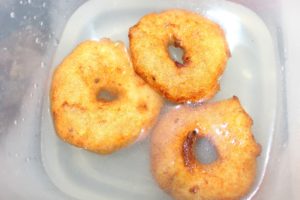
While the vadas are soaking, prepare the yogurt to dip the vadas in. Heat a saucepan for tempering. Add 2 tablespoon of oil to it and when the oil is hot enough, add chana dal, mustard seeds and cumin seeds and allow them to fry till they turn slightly gold in color. Add 2-3 dry red chiles, chopped green chilies, chopped or grated ginger, asafoetida (hing) and a few curry leaves and roast them. Turn the heat off.
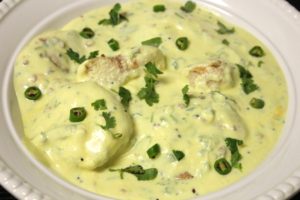
Beat the yogurt along with some water and make it slightly thin. Add some turmeric powder and salt to taste. Pour the tempered lentils and spices on the yogurt and mix it well. Add the soaked vadas to this yogurt mix and garnish it with fresh coriander. You can also add some grated carrot on top. Let them sit for at least 4-6 hours, in order for the vadas to absorb the yogurt and become amazingly soft. These dahi vadas are heavenly and you can have them either chilled or at room temperature. So on your next weekend, indulge yourself in these dahi vadas, South-Indian style! I’m sure your family will love it!
Pakora Recipe:
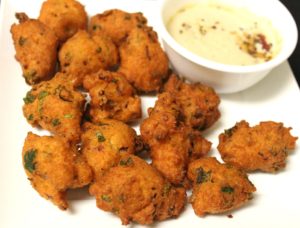
The same vada batter can also be used to make pakoras. Add 2-3 table spoons of rice flour and water to the vada batter and make it thin like pakora batter. Also add a pinch of baking soda to it. Add sliced onions, green chilies and coriander to the batter and mix it well. Heat oil in a pan to deep fry and when the oil is hot enough, drop small portions of the batter in the oil using your hand or a spoon. Fry them over medium heat, till they turn golden brown in color on both sides. Remove the pakoras from the oil and drain them on a paper towel. Transfer them onto a plate to serve them hot with some tomato sauce or a chutney. You can serve these pakoras with some green chutney, tomato chutney or Almond chutney .
Mysore Bonda or Bajji Recipe:
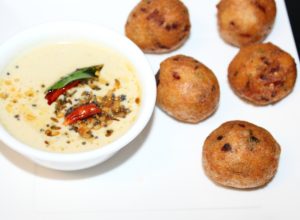
Bondalu or Mysore bajji is another recipe that can be made using the same vada batter. Add some plain yogurt to the urad dal batter and mix it well with your hand, beating the batter in circular motion to let it aerate. This helps the bonda to be fluffy and soft. Add chopped green chilis and onions, if your vada batter doesn’t have them already. You can also add small pieces of coconut for an authentic taste. Heat oil in a pan to deep fry. Take small portions of the batter in your hand and drop them in the hot oil as round balls. Fry them till they turn gold in color and remove them from the oil. Drain them on a paper towel. Serve the bondas while hot along with a nice chutney and enjoy!
Vadiyalu/ Urad dal Vadi Recipe:
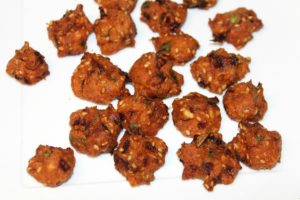
This is an instant recipe to make vadiyalu unlike the traditional method where they’re sun-dried for 2-3 days. This is very helpful for the people living in countries where there’re no sunny weather or not enough place to let them dry under sunlight. You can prepare them in minutes whenever you want and satisfy your craving for vadiyalu. Use the same batter of vada, (follow the recipe given above) that is ground urad dal and add ginger and chili paste, onions and some roasted sesame seeds. Mix the batter well.
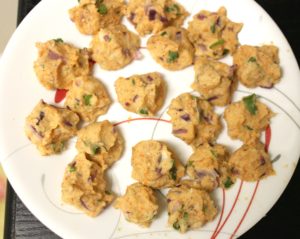
Grease the plate in which you want to place your vadiyalu. Wet your hand before you make vadiyalu. Take a small amount of batter in your hand and place them on the greased plate in desired shapes and sizes. Keep a little gap in between the vadiyalu to keep these pre-made vadiyalu from sticking to each other. Heat this plate in the microwave for 2 minutes. Remove it from the microwave and put it back again for 1-2 minutes. Remove the plate from the microwave and leave it out for 10 minutes. Once the vadiyalu become dry (touch with your finger and test), scale them off from the plate and deep fry in hot oil. Crispy vadiyalu is ready to serve with your favorite dal, sabji or kadi. Enjoy!
Click here to visit my home page for other recipes!
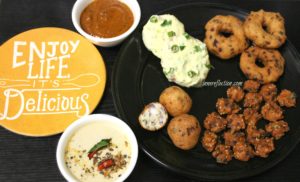


Thanks for one’s marvelous posting! I definitely enjoyged reading it, you will be a great author.
I will be sure to bookmark your blog and will ofen come back in the foreseeable future.
I want to encourage you tto continue your great job, have a nice weekend!
Some genuinely nice and useful information on this website,
besides I think the design and style contains excellent features.
Great posts from you. I have understand your stuff previous to and you
are just extremely wonderful. I really like what you’ve acquired here, really like what
you’re saying and the way in which you say it. You make it enjoyable and you still care for
to keep it sensible. I can not wait to read far more from you.
This is actually a terrific web site.